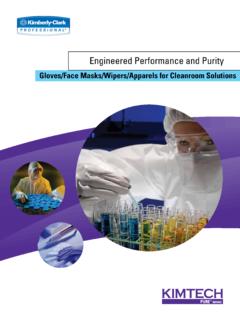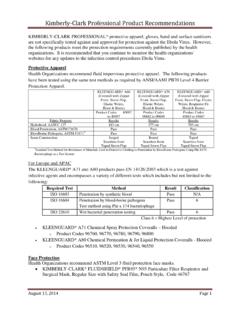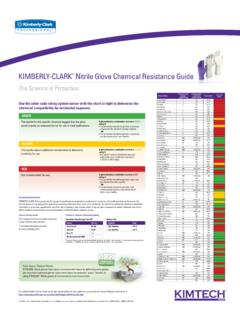Transcription of 1 What makes the KleenGuard* G10 2 How is the KleenGuard ...
1 KleenGuard * G10 Arctic Blue nitrile gloves Frequently Asked Questions Registered Trademarks of Kimberly-Clark Worldwide, Inc. 2004 KCWW. All Rights Reserved. 1 What makes the KleenGuard * G10 Arctic Blue nitrile glove unique? Kimberly-Clark* researchers developed an innovative proprietary compounding process for synthetic nitrile polymers. This process provides two key characteristics users want: 1. Increased comfort 2. Reduced glove thickness, which means that less force is required to stretch the material. The result is a latex-free glove with consistent thickness from fingertip to cuff. The glove combines the dexterity and sensitivity of natural rubber latex with the superior barrier protection qualities of nitrile all at a value price. Many competitors have tried to copy our technology but have been unable to replicate the fingertip-to-cuff consistency and comfort.
2 2 How is the KleenGuard * G10 Arctic Blue nitrile glove different from the KleenGuard * G10 Grey glove? The KleenGuard * G10 Arctic Blue nitrile glove uses a similar process to that of the KleenGuard * G10 Grey glove. The primary advantages of the KleenGuard * G10 Arctic Blue nitrile glove include: 1. Increased comfort relative to the G10 Grey glove due to the lower mil thickness ( mil vs. mil for the G10 Arctic Blue) and glove pliability 2. A much better environmental story: G10 Arctic Blue saves up to tons of waste per year (55% less waste) vs. tons for G10 Grey (33% less waste) please refer to Space & Waste charts 3. Lower price per glove The KleenGuard * G10 Arctic Blue nitrile glove is being positioned for comfort and value. The KleenGuard * G10 Grey nitrile is positioned for strength and dexterity. Both glove families offer Environmental advantages. 3 How is the KleenGuard * G10 Arctic Blue nitrile glove different from the Kimberly-Clark* Lavender* Exam glove?
3 The KleenGuard * G10 Arctic Blue nitrile glove takes advantage of the same innovative manufacturing process used to manufacture of the Kimberly-Clark* Lavender* Exam glove but with a few differences: 1. Added 1 cm in length (24 cm) for improved coverage 2. Boosted the strength characteristics vs. the Kimberly-Clark* Lavender* Exam glove 3. The product has been developed with the industrial market in mind; as such, the manufacturing specifications and some of the processing steps have been changed. Hence, the product is not FDA cleared as a medical Exam glove 4 What is the difference between an Industrial glove and a Medical Exam glove? Medical Exam gloves are FDA cleared through the 510K process. This requires manufacturers meet rigorous standards and testing to prove the gloves equivalent to other gloves in the market. The data is then submitted to the FDA for clearance (this is done through submission of a 510K).
4 Any glove labeled as Exam requires FDA clearance before it can be sold in the United States. On the other hand, Industrial gloves do not have to meet this requirement. However, we at Kimberly-Clark Professional* follow the same rigorous standards as in the manufacturing of our Medical Exam gloves (with appropriate adaptation for the Industrial glove market). 5 What does Food Handling Certification mean and how are we certified? Food Handling Certification means gloves can be used in direct contact with food without harming the user, food or end-user. In the USA, our gloves are self-certified for Food Handling we review the composition of the glove to ensure no harmful components end up in the food handling process or food. In Canada, testing data as well as samples of the glove are submitted to the Canadian Food Handling Agency ( CFIA) for certification. In Europe, rigorous testing is followed.
5 Data and glove samples are submitted to the appropriate Notified Body for review and approval. 6 The KleenGuard * G10 Grey nitrile glove and the G10 Arctic Blue nitrile glove are mil-thick and mil thick, respectively. Yet, they differ in price by only ~15%. Why is that? Shouldn t a glove that is only half as thick be half the price? The best way to explain the cost of the glove is to first understand the components that go into making the KleenGuard * G10 Arctic Blue nitrile gloves Frequently Asked Questions Registered Trademarks of Kimberly-Clark Worldwide, Inc. 2004 KCWW. All Rights Reserved. glove: the raw materials, labor and other fixed costs as well as the final gram weight of the gloves . In our specific scenario, the final weight of each glove is grams and grams, respectively. This is only a 24% decrease in the weight of the glove not a 50% decrease what our mil thickness would lead us to believe.
6 Although we, in fact, can reduce the cost of the raw materials when making the gloves thinner, the manufacturing overhead and other fixed costs to make each glove do not change in fact the manufacturing costs become a larger portion of the cost of the glove ( , thinning out the gloves from mil to mil does not enable the manufacturing line to make twice as many gloves nor does it cut the labor costs) 7 Does the KleenGuard * G10 Arctic Blue nitrile glove have a smooth or textured finish? The glove has textured fingertips to enhance wet and dry gripping. 8 Does the KleenGuard * G10 Arctic Blue nitrile glove have an inner chemical coating? No. The only chemical interaction the gloves go through after stripping from the former is the normal chlorination process that removes the residual powder and excess tack. 9 How is the durability and barrier protection of the glove compared to other glove materials (latex, vinyl, etc.)
7 ? The glove s proprietary nitrile formulation gives it excellent comfort and barrier protection for most low and moderate situations (similar to latex). Kimberly-Clark recommends vinyl gloves in only low risk situations. 10 Are there any differences in the packaging of this glove compared to others in the market? Yes. The KleenGuard * G10 glove is packaged as 200 gloves /box or 2,000 gloves per case (1,800 for XL gloves ). Traditional industrial glove packaging contains 100 gloves /box or 1,000 gloves per case. The KleenGuard * G10 Arctic Blue nitrile higher pack count results in space & waste savings (see the Space & Waste Greenmeter for details). Although some competitors today have 2,000 gloves per case, they still package gloves as 100/box which results in increased waste per case. 11 Does the KleenGuard * G10 Arctic Blue nitrile glove provide any waste disposal savings?
8 Yes. On average, the KleenGuard * G10 Arctic Blue nitrile gloves weigh less than other industrial gloves , while still providing superior barrier protection, and are packaged 2,000 gloves per case (XL = 1,800). That means we can reduce glove and packaging waste disposal costs by over 55% simply by switching to the KleenGuard * G10 Arctic Blue nitrile (see Waste Savings Chart). Although some competitors today have 2,000 gloves per case, they still package gloves as 100/box which results in increased waste per case vs. our KleenGuard * G10 Arctic Blue nitrile glove. 12 Does the KleenGuard * G10 Arctic Blue nitrile glove provide any space savings? Yes. The KleenGuard * G10 nitrile glove packaging configuration results in a 50% space savings in your storage areas (see Space Savings Chart). That means you can keep the same safety stock of gloves you currently have, while freeing up valuable storage space for other critical items.
9 LATEX-RELATED QUESTIONS 13 When were latex allergies first discovered? This first clear description of immediate hypersensitivity to latex was published in 1979. In the late 1980 s and early 1990 s there was a dramatic increase in reported cases of latex sensitivity coinciding with the increased use of latex gloves to protect healthcare workers against exposure to AIDS. 14 How many Americans suffer from allergic diseases? More than 50 million Americans suffer from allergic diseases. Estimates of the prevalence of latex allergies in the general population vary from less than one percent to six percent. The cost to resolve a KleenGuard * G10 Arctic Blue nitrile gloves Frequently Asked Questions Registered Trademarks of Kimberly-Clark Worldwide, Inc. 2004 KCWW. All Rights Reserved. latex allergy incident can be as high as $285,000. 15 Do people develop a reaction immediately upon exposure to a latex substance?
10 Latex sensitization develops after multiple exposures over a highly variable period of time. The latency period ranges from several weeks to as long as 30 years. It s impossible to predict when an exposed individual will become latex sensitive. 16 Is there any cure for Type I latex allergies? To date, there is no known cure for latex allergy. 17 Does the KleenGuard * G10 Arctic Blue nitrile Glove remove the risk of Type I allergic reactions to latex proteins? The KleenGuard * G10 Arctic Blue nitrile glove is made from a natural rubber latex-free formulation removing the risk of Type I allergic reactions to latex proteins.










